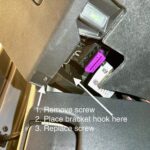Finding the OBD2 connector in your 2000 Honda CRV can sometimes be a bit puzzling, especially if you’re new to car diagnostics. This port is essential for accessing your vehicle’s computer system to read trouble codes, diagnose issues, and ensure your car is running smoothly. While the location is generally standardized, some variations can occur. Let’s explore where you’re most likely to find the OBD2 connector in your 2000 CRV and what to do if you’re having trouble locating it.
Where to Typically Find the OBD2 Port in a 2000 Honda CRV
In the 2000 Honda CRV, the OBD2 connector is commonly located within the passenger side footwell area. You’ll want to look under the dashboard, near the center console. It’s often positioned in a bracket or holder, which might be made of metal or plastic.
To pinpoint it:
- Get into the passenger seat: This gives you the best vantage point.
- Look under the dash: Shine a flashlight if needed to see into the darker areas.
- Search near the center console: The connector is usually somewhere in the vicinity where the center console meets the underside of the dashboard on the passenger side.
- Identify the shape: The OBD2 connector is typically a trapezoidal 16-pin female connector. It’s designed to be easily plugged into by diagnostic scan tools.
It’s possible the connector is mounted in a bracket, which could be oriented horizontally or vertically. Some brackets might have notches or specific shapes designed to hold the OBD2 port securely.
 OBD2 Connector Location in Honda CRV Passenger Footwell
OBD2 Connector Location in Honda CRV Passenger Footwell
Image showing the general area of an OBD2 connector location in a vehicle footwell, emphasizing the under-dash and passenger side vicinity.
Troubleshooting if You Can’t Immediately Locate the Connector
If you’ve checked the common passenger footwell location and still can’t find the OBD2 connector, here are a few things to consider:
Check for a Disconnected Connector
It’s less common, but sometimes the OBD2 connector can become dislodged from its holder. Carefully inspect the area behind where the connector should be. It’s possible it has been pushed out of its bracket and is hanging loose or tucked further up under the dash. Look for any dangling wires or a connector that might have been pushed out of sight.
Verify Connector Type
While OBD2 is the standard, it’s always good to visually confirm the connector type. The OBD2 port should have 16 pins and a specific trapezoidal shape. Refer to online images of OBD2 connectors if you are unsure. While highly unlikely for a 2000 CRV, ensure it resembles the standard OBD2 port and not an older, proprietary connector.
Consult Your Honda CRV Owner’s Manual
Your 2000 Honda CRV owner’s manual is a valuable resource. While it may not explicitly point out the OBD2 connector location, it might offer diagrams of dashboard components or fuse box locations that can give you a better spatial understanding of the under-dash area.
Seek Advice from Online CRV Communities and Forums
Online forums and communities dedicated to Honda CRVs can be incredibly helpful. Other owners of 2000 CRVs may have encountered similar location challenges and can provide specific advice or even photos of the connector location in their vehicles.
Consider Professional Assistance
If you’ve exhausted all DIY location efforts, consider seeking assistance from a professional mechanic. They will be able to quickly locate the OBD2 port and can also diagnose any issues if the port is indeed missing or damaged.
The Importance of the OBD2 Connector for Your 2000 CRV
The OBD2 connector is your gateway to understanding your 2000 Honda CRV’s health. Through this port, mechanics and DIYers alike can:
- Read Diagnostic Trouble Codes (DTCs): Identify the source of “check engine light” and other warning lights.
- Access Real-time Data: Monitor engine performance, sensor readings, and other crucial parameters.
- Perform Emissions Testing: OBD2 compliance is often required for emissions inspections.
- Reset Check Engine Lights: After repairs, clear codes and confirm the issue is resolved.
Knowing the location of your OBD2 connector empowers you to take a proactive approach to vehicle maintenance and diagnostics. Whether you’re using a basic code reader or more advanced scan tools, accessing this port is the first step in understanding and addressing your 2000 Honda CRV’s diagnostic information.
In conclusion, for a 2000 Honda CRV, the OBD2 connector is most likely situated in the passenger side footwell, under the dashboard near the center console. Take your time, use a flashlight, and you should be able to locate this vital diagnostic port and gain access to your vehicle’s onboard computer system.
